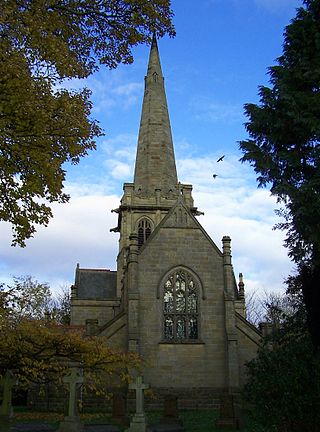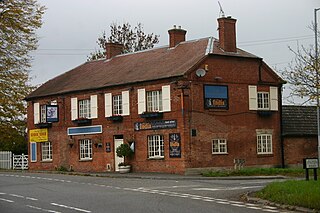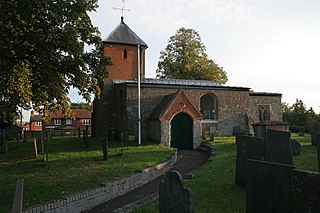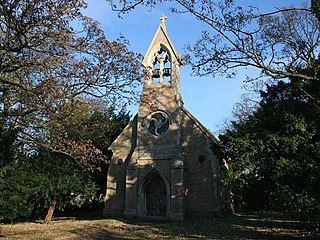
Bingham was a wapentake of the historic county of Nottinghamshire, England. It was in the south-east of the county, to the south of the River Trent.

Colston Bassett is an English village in the Vale of Belvoir, in the Rushcliffe district of south-east Nottinghamshire, close to its border with Leicestershire. It lies by the River Smite. The population in 2001 of 225, including Wiverton Hall, increased to 399 at the 2011 Census.

Granby is a small village in the Rushcliffe district of Nottinghamshire, England. It lies in the Vale of Belvoir.
Barnstone is an English village in the Rushcliffe borough of Nottinghamshire, forming part of Langar cum Barnstone parish. It lies on the border with Leicestershire. The nearest retail stores, schools and railway station are in Bingham. The spelling in the 19th century was usually "Barnston". The parish church of St Mary's belongs to the Wiverton group, but is not currently in use.

Tithby is an English village in the Rushcliffe borough of Nottinghamshire, about 2.6 miles (4.2 km) south of the market town of Bingham. The civil parishes of Tithby and Wiverton Hall have a joint annual parish meeting and a combined population of about 95.

Elton on the Hill is a small Nottinghamshire village and civil parish in the Vale of Belvoir. The population of about 75 is included with the civil parish of Granby for census purposes.

St Andrew's Church, Langar-cum-Barnstone, is a parish church in the Church of England in Langar, Nottinghamshire. It is Grade I listed as a building of outstanding architectural or historic interest.

All Saints', Granby is a Church of England parish church in Granby, Nottinghamshire, England. The building is Grade I listed by the Department for Digital, Culture, Media and Sport for outstanding architectural or historic interest.

Holy Trinity Church, Tythby is a parish church in the Church of England in the English village of Tithby, Nottinghamshire. The building is Grade I listed.

St Mary's Church, Barnstone is a parish church in the Diocese of Southwell and Nottingham of the Church of England, situated in Barnstone, Nottinghamshire. It was completed as a chapel of ease for St Andrew's Church, Langar in 1857 in Gothic Revival style.

St Michael and All Angels' Church, Elton on the Hill is a parish church in the Church of England in Elton on the Hill, Nottinghamshire. It is Grade II listed by the Department for Digital, Culture, Media and Sport as a building of special architectural interest.
Sutton-cum-Granby is a hamlet in the Borough of Rushcliffe in Nottinghamshire, England. It lies in the Vale of Belvoir.

John Grobham Howe (1625–1679) of Langar Hall, Nottinghamshire, was an English politician who sat in the House of Commons between 1659 and 1679.

Langar Hall is a Grade II listed house, now a hotel, next to the church in Langar, Nottinghamshire.

Wiverton Hall is an English country house near Tithby, Nottinghamshire. By 1510 the former village of Wyverton had become impoverished and reduced to just four houses and a cottage. It was in that year completely depopulated by "emparkment", when George Chaworth enlarged his park by 254 acres. All but the Grade II* listed gatehouse of the mansion was destroyed in the English Civil War. The current house dates from 1814.

Langar cum Barnstone is a civil parish in the Rushcliffe borough, within the county of Nottinghamshire, England. The overall area had a population of 980 at the 2011 census. The parish lies near the county border with Leicestershire. It lies 120 miles north of London, 4 miles south east of Bingham and 12 miles south east from the city of Nottingham.
Parish council elections took place across Rushcliffe's parishes on 2 May 2019, alongside local elections in the borough.
Langar cum Barnstone is a civil parish in the Rushcliffe district of Nottinghamshire, England. The parish contains 24 listed buildings that are recorded in the National Heritage List for England. Of these, one is listed at Grade I, the highest of the three grades, one is at Grade II*, the middle grade, and the others are at Grade II, the lowest grade. The parish contains the villages of Langar and Barnstone and the surrounding countryside. All the listed buildings are in the villages, and consist of a church, tombs and headstones in the churchyard, the churchyard wall, houses, cottages and associated structures, farmhouses and farm buildings, a public house, a former school, a war memorial and a telephone kiosk.
















